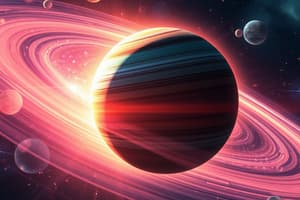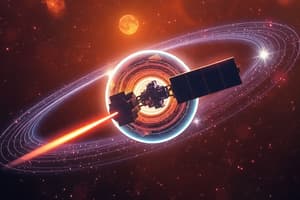Podcast
Questions and Answers
What is the primary reason why all the planets have orbits around the Sun in the same direction and plane?
What is the primary reason why all the planets have orbits around the Sun in the same direction and plane?
- The planets were formed by the accretion of dust and debris around the Sun
- The planets were formed by the explosion of a supernova
- The planets were formed at different times and locations
- The planets were formed by the gravitational collapse of a rotating cloud of gas and dust (correct)
What is the key similarity between throwing a ball out of a tower window and launching a satellite into orbit?
What is the key similarity between throwing a ball out of a tower window and launching a satellite into orbit?
- Both require the object to travel at a certain speed
- Both require a push to initiate the motion (correct)
- Both involve gravity keeping the object in motion
- Both result in the object falling back to the ground
What is the key advantage of satellites in geostationary orbit (GEO) compared to other satellite orbits?
What is the key advantage of satellites in geostationary orbit (GEO) compared to other satellite orbits?
- They require less fuel to maintain their orbit
- They can observe larger areas of the Earth
- They can be launched to a higher altitude
- They can stay constantly above a fixed point on the Earth's surface (correct)
What is the primary reason why satellites in geostationary orbit (GEO) need to travel at a speed of about 3 km/s?
What is the primary reason why satellites in geostationary orbit (GEO) need to travel at a speed of about 3 km/s?
Which of the following is a key advantage of having satellites in orbit around the Earth?
Which of the following is a key advantage of having satellites in orbit around the Earth?
What is the primary force responsible for an object orbiting another?
What is the primary force responsible for an object orbiting another?
In our Solar System, which of the following is true regarding orbits?
In our Solar System, which of the following is true regarding orbits?
How did the planets, moons, and asteroids in our Solar System form?
How did the planets, moons, and asteroids in our Solar System form?
What happens when objects of similar mass orbit each other?
What happens when objects of similar mass orbit each other?
What is the primary reason for the formation of tides in Earth's oceans?
What is the primary reason for the formation of tides in Earth's oceans?
Flashcards are hidden until you start studying




